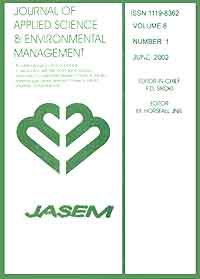
|
Journal of Applied Sciences and Environmental Management
World Bank assisted National Agricultural Research Project (NARP) - University of Port Harcourt
ISSN: 1119-8362
Vol. 7, No. 2, 2003, pp. 59-61
|
 Bioline Code: ja03021
Bioline Code: ja03021
Full paper language: English
Document type: Research Article
Document available free of charge
|
|
|
Journal of Applied Sciences and Environmental Management, Vol. 7, No. 2, 2003, pp. 59-61
| en |
The Effect of Acute Plasmodium falciparum  Infection on the levels of Malondialdehyde (MDA) and Ascorbic acid on Nigerian Children Infection on the levels of Malondialdehyde (MDA) and Ascorbic acid on Nigerian Children
ISAMAH, G K; ASAGBA, S O
Abstract
The effect of acute plasmodium falciparum infection on the levels of malondialdehyde (MDA) and ascorbic acid (AA) were studied in 200 children infested with malaria between the ages of 0.5 - 5 years with a male to female ratio of 3:1. Healthy children (n = 200) matched for age and sex ratio served as control. MDA content was significantly higher (P < 0.01) in the plasma of malarias children (13.88 ± 1.02 μmol/m) compared to the control (8.71 ± 0.62 μmol/ml) However, AA level showed an opposite response: malarias children (87.41 ± 3.43 μmol/ml) and control (122.07 ± 6.36 μmol/ml). These results were also highly significant (P < 0.01). Also a negative correlation (r = -0.525) was observed between these two parameters in the malarias children against a positive correlation (r = 0.533) in the control. These opposite responses in the level of lipid peroxidation and ascorbic acid may in part account for the general tissue damage associated with the pathology of malaria. @JASEM
|
| |
© Copyright 2003 - Journal of Applied Sciences & Environmental Management
|
|
